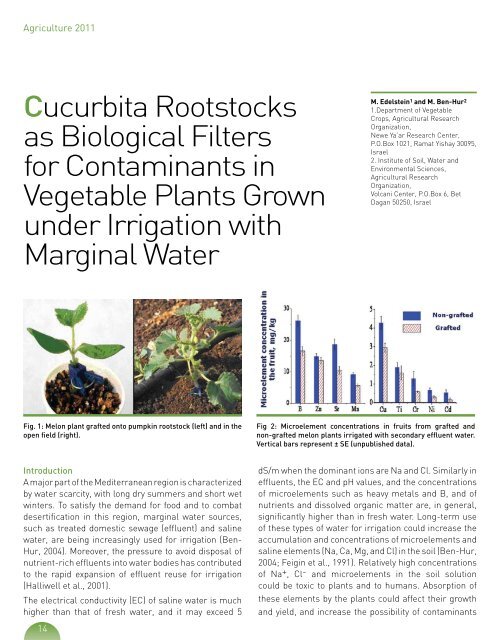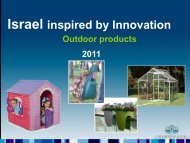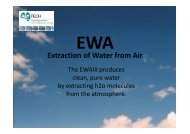PDF file - Israel Trade Commission
PDF file - Israel Trade Commission
PDF file - Israel Trade Commission
Create successful ePaper yourself
Turn your PDF publications into a flip-book with our unique Google optimized e-Paper software.
Agriculture 2011<br />
Cucurbita Rootstocks<br />
as Biological Filters<br />
for Contaminants in<br />
Vegetable Plants Grown<br />
under Irrigation with<br />
Marginal Water<br />
M. Edelstein 1 and M. Ben-Hur 2<br />
1.Department of Vegetable<br />
Crops, Agricultural Research<br />
Organization,<br />
Newe Ya’ar Research Center,<br />
P.O.Box 1021, Ramat Yishay 30095,<br />
<strong>Israel</strong><br />
2. Institute of Soil, Water and<br />
Environmental Sciences,<br />
Agricultural Research<br />
Organization,<br />
Volcani Center, P.O.Box 6, Bet<br />
Dagan 50250, <strong>Israel</strong><br />
Fig. 1: Melon plant grafted onto pumpkin rootstock (left) and in the<br />
open field (right).<br />
Fig 2: Microelement concentrations in fruits from grafted and<br />
non-grafted melon plants irrigated with secondary effluent water.<br />
Vertical bars represent ± SE (unpublished data).<br />
Introduction<br />
A major part of the Mediterranean region is characterized<br />
by water scarcity, with long dry summers and short wet<br />
winters. To satisfy the demand for food and to combat<br />
desertification in this region, marginal water sources,<br />
such as treated domestic sewage (effluent) and saline<br />
water, are being increasingly used for irrigation (Ben-<br />
Hur, 2004). Moreover, the pressure to avoid disposal of<br />
nutrient-rich effluents into water bodies has contributed<br />
to the rapid expansion of effluent reuse for irrigation<br />
(Halliwell et al., 2001).<br />
The electrical conductivity (EC) of saline water is much<br />
higher than that of fresh water, and it may exceed 5<br />
dS/m when the dominant ions are Na and Cl. Similarly in<br />
effluents, the EC and pH values, and the concentrations<br />
of microelements such as heavy metals and B, and of<br />
nutrients and dissolved organic matter are, in general,<br />
significantly higher than in fresh water. Long-term use<br />
of these types of water for irrigation could increase the<br />
accumulation and concentrations of microelements and<br />
saline elements (Na, Ca, Mg, and Cl) in the soil (Ben-Hur,<br />
2004; Feigin et al., 1991). Relatively high concentrations<br />
of Na + , Cl - and microelements in the soil solution<br />
could be toxic to plants and to humans. Absorption of<br />
these elements by the plants could affect their growth<br />
and yield, and increase the possibility of contaminants<br />
14
















